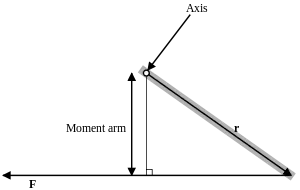Torque
| click to expand or collapse | ||||||||||||||
|---|---|---|---|---|---|---|---|---|---|---|---|---|---|---|
|
Angular Acceleration
| click to expand or collapse | ||||
|---|---|---|---|---|
|
If the torques on an object cancel out, the net torque is zero and the angular acceleration is also zero. For example, a beam that can rotate about its axis has two forces exerted on it and therefore two torques (see figure 3 below).
- ↑ Serway, R. A. and Jewett, Jr. J. W. (2003). Physics for Scientists and Engineers. 6th Ed. Brooks Cole. ISBN 0-53440-842-7.
- ↑ Tipler, Paul (2004). Physics for Scientists and Engineers: Mechanics, Oscillations and Waves, Thermodynamics (5th ed.). W. H. Freeman. ISBN 0-7167-0809-4.
- ↑ For example, a force of three w:newtons applied two w:meters from the fulcrum exerts the same torque as one newton applied six meters from the fulcrum. This assumes the force is in a direction at w:right angles to the straight lever. The direction of the torque can be determined by using the right hand rule: Using your right hand, curl your fingers in the direction of rotation, and stick your thumb out so it is aligned with the axis of rotation. Your thumb points in the direction of the torque vector. http://hyperphysics.phy-astr.gsu.edu/hbase/tord.html
- ↑ "SI brochure Ed. 8, Section 5.1". Bureau International des Poids et Mesures. 2006. Retrieved 2007-04-01.
- ↑ "SI brochure Ed. 8, Section 2.2.2". Bureau International des Poids et Mesures. 2006. Retrieved 2007-04-01.
